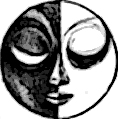wtorek, 1 kwietnia 2003
Ubogi autor i majętny księgarz” (1811)Washington Allston; mowa ciała gest bidny ten autor depresyjny wychudzony głodny?
Księżyc ma dwie strony -jasną i ciemną. Każda jest potrzebna do bycia pełnią. Odrodzenie Nowego Księżyca
ART......O Art, high gift of Heaven! how oft defamed When seeming praised! To most a craft that fits, By dead, prescriptive Rule, the scattered bits Of gathered knowledge; even so misnamed By some who would invoke thee; but not so By him,—the noble Tuscan,*—who gave birth To forms unseen of man, unknown to Earth, Now living habitants; he felt the glow Of thy revealing touch, that brought to view The invisible Idea; and he knew, E'en by his inward sense, its form was true: 'T was life to life responding, - highest truth! So, through Elisha's faith, the Hebrew Youth Beheld the thin blue air to fiery chariots grow..................................2 .............A SMILE...............
zdne aluzje, ale cA smile!—Alas, how oft the lips that bear This floweret of the soul but give to air, Like flowering graves, the growth of buried care! Then drear indeed that miserable heart Where this last human boon is aye denied! If such there be, it claims in man no part, Whose deepest grief has yet a mirthful bride. For whose so many as the sad man's face? His joy, though brief, is yet reprieve from woe; The waters of his life in darkness flow; Yet, when the accidents of time displace The cares that vault their channel, and let in A gleam of day, with what a joyous din The stream jets out to catch the sunny grace!..................MYŚL.Thought What master-voice shall from the dim profound Of Thought evoke its fearful, mighty Powers?— Those dread enchanters, whose terrific call May never be gainsaid; whose wondrous thrall Alone the Infinite, the Uncreate, may bound; In whose dark presence e'en the Reason cowers, Lost in their mystery, e'en while her slaves, Doing her proud behests. Ay, who to sense Shall bring them forth?—those subtile Powers that wear No shape their own, yet to the mind dispense All shapes that be. Or who in deepest graves Seal down the crime which they shall not uptear?— Those fierce avengers, whom the murdered dead Shall hear, and follow to the murderer's bed.iekawe jaka była pra-intencja i historia tego obrazu Washington Allston „Ubogi autor i majętny księgarz” (1811),
FRAGMENTY MINY GESTY PIES
Washington Allston The Poor Author and the Rich Bookseller, 1811 Museum of Fine Arts, Boston.
dziwny autor malarz/pisarz amerykański
Washington Allston was the first to use (apparently) the term Objective Correlative in 1840 which subsequently revived and made famous by T.S Eliot in essay on Hamlet (1919). The term denotes a set of objects, a situation, a chain of events which shall be the formula of that particular emotion; such that when the external facts, which must terminate in sensory experience, are given, the emotion is immediately evoked. Washington Allston Belshazzar’s feast -kilka dziesia naście lat malował Ucztę baltazara, nawet w gniu śmierci- Washington Allston Belshazzar’s feast he heroic Belshazzar's Feast (1817-1843) was out of keeping with the more subdued mood of the American period. This huge canvas, begun in Europe, was taken up, put down, and taken up again at the end of Allston's life but never finished. Allston was preparing to work on the figure of the King on the day of his death. The painting was commissioned by 10 friends for $10,000; the image of the prophet Daniel interpreting the handwriting on the wall haunted Allston to the point that he found himself unable to undertake other commissions. Dana spoke of it as "that terrible vision … the tormentor of his life… " In a sense, Allston's failure to complete this work demonstrates the isolation and frustration of the American artist who wished to do something more than portraiture and landscape in the first half of the 19th century
zaczął 1817 - i poprawiał -nie dokonczył co widać na tym fragmencie do dnia śmierci ciekawe - ciekawe tło miedzy postaciami Tajemnicza Nitoris i King....Nitocris of Babylon (c. 550 BC) is an otherwise unknown queen of Babylon described by Herodotus in his Histories. According to Herodotus she was the wife of Nabonidus (Gr. Labynetus) against whose son Cyrus the Great launched an expedition.] Dougherty and Beaulieu identify the son as Belshazzar.[] If this is the case, she is most likely the queen in the story of Belshazzar's feast, and she is identified as such in Handel's oratorio Belshazzar. She is credited by Herodotus with various building projects in Babylon. She is also said to have tricked Darius I by placing her tomb above a gate so that no Persian could pass below and enter through. According to the account, Darius was lured in by a mysterious inscription that served as a trap for greedy kings -do zgłębienia. Washington Allston ARA (November 5, 1779 – July 9, 1843)
Washington Allston was the first to use (apparently) the term Objective Correlative in 1840 which subsequently revived and made famous by T.S Eliot in essay on Hamlet (1919). The term denotes a set of objects, a situation, a chain of events which shall be the formula of that particular emotion; such that when the external facts, which must terminate in sensory experience, are given, the emotion is immediately evoked. Washington Allston Belshazzar’s feast -kilka dziesia naście lat malował Ucztę baltazara, nawet w gniu śmierci- Washington Allston Belshazzar’s feast he heroic Belshazzar's Feast (1817-1843) was out of keeping with the more subdued mood of the American period. This huge canvas, begun in Europe, was taken up, put down, and taken up again at the end of Allston's life but never finished. Allston was preparing to work on the figure of the King on the day of his death. The painting was commissioned by 10 friends for $10,000; the image of the prophet Daniel interpreting the handwriting on the wall haunted Allston to the point that he found himself unable to undertake other commissions. Dana spoke of it as "that terrible vision … the tormentor of his life… " In a sense, Allston's failure to complete this work demonstrates the isolation and frustration of the American artist who wished to do something more than portraiture and landscape in the first half of the 19th century
zaczął 1817 - i poprawiał -nie dokonczył co widać na tym fragmencie do dnia śmierci ciekawe - ciekawe tło miedzy postaciami Tajemnicza Nitoris i King....Nitocris of Babylon (c. 550 BC) is an otherwise unknown queen of Babylon described by Herodotus in his Histories. According to Herodotus she was the wife of Nabonidus (Gr. Labynetus) against whose son Cyrus the Great launched an expedition.] Dougherty and Beaulieu identify the son as Belshazzar.[] If this is the case, she is most likely the queen in the story of Belshazzar's feast, and she is identified as such in Handel's oratorio Belshazzar. She is credited by Herodotus with various building projects in Babylon. She is also said to have tricked Darius I by placing her tomb above a gate so that no Persian could pass below and enter through. According to the account, Darius was lured in by a mysterious inscription that served as a trap for greedy kings -do zgłębienia. Washington Allston ARA (November 5, 1779 – July 9, 1843)
Subskrybuj:
Posty (Atom)










